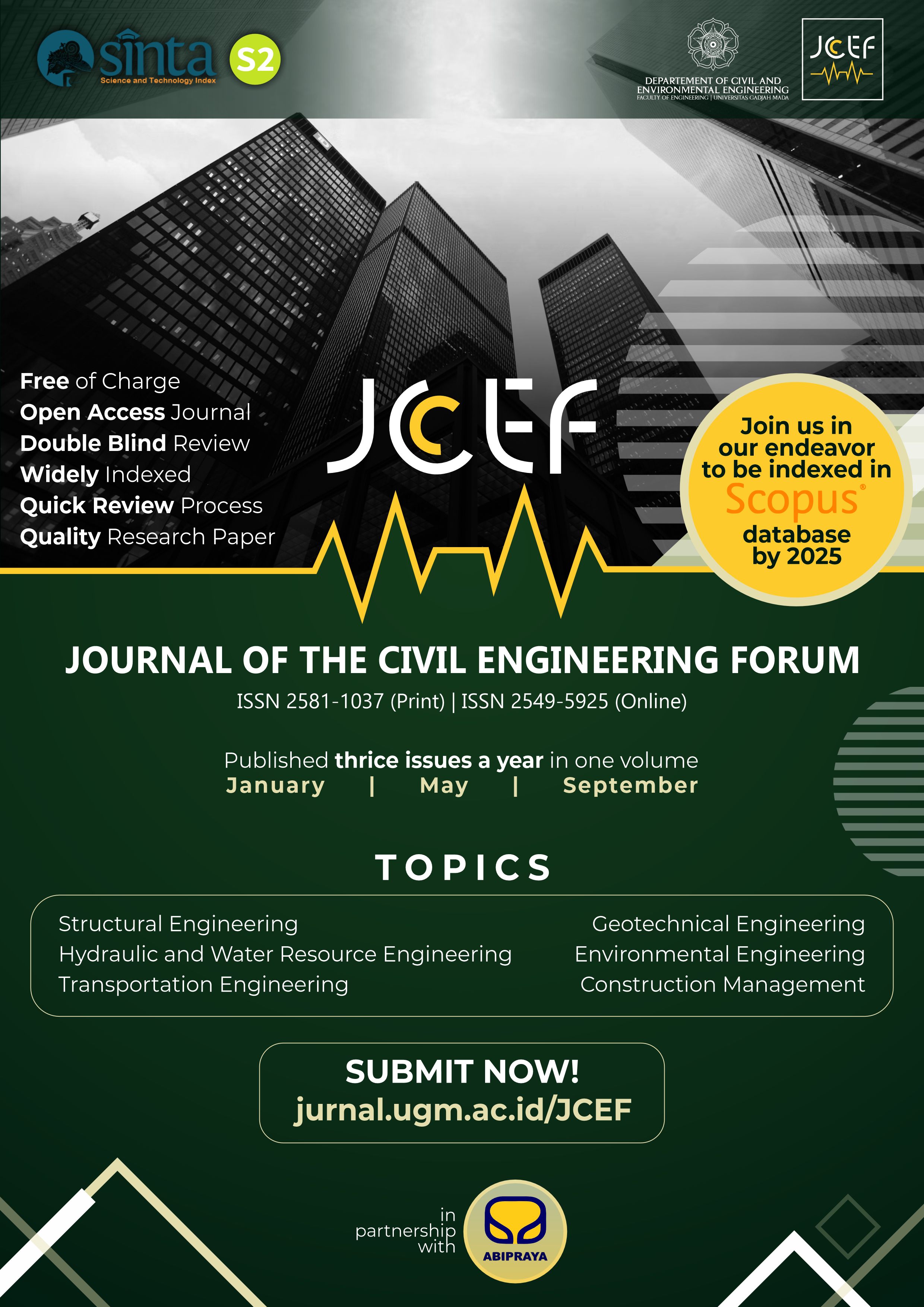Problems and Solutions for the Flood Control Program in Medan City and its Surroundings
Abstract
Medan City is currently experiencing flooding and this indicates all existing flood control projects implemented over the years have been unsuccessful. Therefore, the main objective of this research is to determine the best solution to overcome floods in the city through a literature study supplemented by a perception survey. The steps implemented include discovering the causes of the flood, determining the failure of the past flood control projects, disclosing the perception of the people affected by floods toward the city government’s commitment, and formulating the best solution to overcome the flood. It was discovered that there are two kinds of floods in Medan city which include the flash/river and the local/residence floods. The flash type was caused by the deforestation in the upstream area of the rivers flowing through the city while the local type is associated with high rainfall, lack of pervious area, and poor urban stormwater management. Moreover, the existing flood mitigation projects were observed to be unsuccessful because they applied the old paradigm with a normalization approach without compensating for the increase in the runoff discharge. This means there is a need to establish naturalization in the upper region of all rivers flowing through the city to reduce river flooding. The maintenance of the existing urban drainage system also needs to be combined with sustainable programs such as storing, absorbing, and reusing strategies to mitigate residence flooding. Furthermore, ten recommendations were proposed to stakeholders to overcome or significantly reduce flooding in Medan City and its surroundings. The first is the alignment of paradigms among stakeholders toward flood management while the last is completing related regulations and law enforcement.
References
Armitage, N., Vice, M., Fisher-Jeffe, S. L., Winter, K., Spiegel, A. & Dunstan, J., 2013. Alternative Technology for Storm Water Management: The South African Guidelines for Sustainable Drainage Systems. University of Cape Town.
BMKG-WIL I, 2019. Badan Meteorologi, Klimatologi dan Geofisika (Meteorology, Climatology and Geophysics Agency), Maximum Rainfall Data from 2009 to 2018. Balai Besar Wilayah I Medan.
DKPM, 2020. Dinas Kominfo Pemko Medan Medan (City Communication and Information Agency). Accessed on 24.02.2020. Available at https://pemkomedan.go.id/hasil-poling.html
Gunawan R., 2010. Gagalnya Sistem Kanal Pengendalian Banjir Jakarta dari Masa ke Masa (Failure of the Jakarta Flood Control Canal System from Time to Time). Kompas. Jakarta
Konsultan Rekayasa Utama, 2017a. Final Report of Feasibility Study of Retention Pond in Medan Polonia Sub District. Medan, Indonesia.
Konsultan Rekayasa Utama, 2017b. Final Report of Feasibility Study of Retention Pond in Medan Johor Sub District. Medan, Indonesia.
Le-Jalle, C., Desille, D., Burkhardt, G., 2013. Urban Stormwater Management in Developing Countries. Vovatech
MLHR-RI, 2011. Minister of Law and Human Rights of the Republic of Indonesia. Government Regulation No.38 / 2011 concerning River. Jakarta.
MPW-RI, 2014. Ministry of Public Work of the Republic of Indonesia. Minister of Public Works Regulation No. 12 /PRT/M/2014 concerning the Implementation of the Urban Drainage System – Appendix 1. Jakarta.
MPW-RI, 2015a. Ministry of Public Work of the Republic of Indonesia. Minister of Public Works and Public Housing Regulation no.4 /PRT/M/ 2015 concerning the determination of river areas. Jakarta.
MPW-RI, 2015b. Ministry of Public Work of the Republic of Indonesia. Minister of Public Works and Public Housing Regulation no.28 /PRT/M /2015 concerning the determination of river and lake border lines. Jakarta.
Nefta Consultan, 2017a. Final Report of Feasibility Study of Retention Pond in Medan Tuntungan Sub District. Medan, Indonesia.
Nefta Consultan, 2017b. Final Report of Feasibility Study of Retention Pond in Medan Selayang Sub District. Medan, Indonesia.
Parkinson, J. and Mark, O., 2005. Urban Stormwater Management in Developing Countries. IWA Publishing, Alliance House, 12 Caxton Street, London SW1H 0QS, UK.
Pemeta International, 2017. Final Report of Feasibility Study of Retention Pond in Medan Sunggal Sub District. Medan, Indonesia.
PRC-RI, 2007. People's Representative Council of Republic of Indonesia. Law no.26 of 2007 concerning Spatial Planning. Jakarta.
PRC-RI, 2019. People's Representative Council of Republic of Indonesia Law no.17 of 2019 concerning water resources. Jakarta.
PT MKJ, 2013. PT Multi Karadiguna Jasa. Final Report of Drainage Master Plan of Medan City. Medan City Government. Medan, Indonesia
TKTPB, 2019. Tim Koordinasi Terpadu Penanggulangan Banjir Kota Medan dan Sekitarnya (Integrated Flood Mitigation Team of Medan City and Surrounding). Medan Flood-Free Blueprint Book (MFFBB). Medan, Indonesia.
Copyright (c) 2023 The Author(s)

This work is licensed under a Creative Commons Attribution-ShareAlike 4.0 International License.
Copyright is granted to authors for the purpose of providing protection for articles written to describe experiments and their results. JCEF will protect and defend the work and reputation of the author and are also willing to address any allegations of violation, plagiarism, fraud, etc. against articles written and published by JCEF. JCEF is published under the terms of the Creative Commons Attribution-ShareAlike 4.0 International License (CC BY-SA 4.0). The author holds the copyright and assigns the journal rights to the first publication (online and print) of the work simultaneously.




